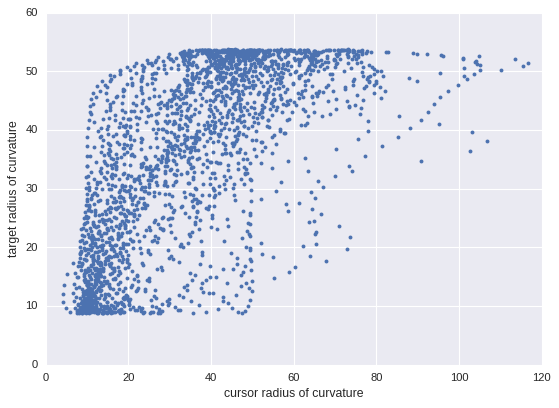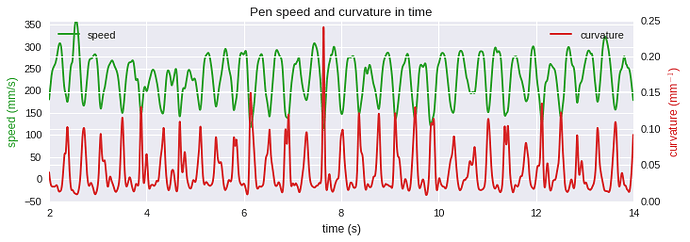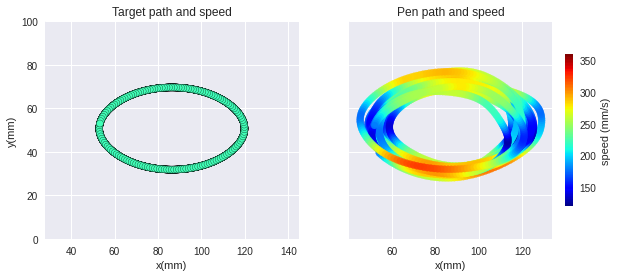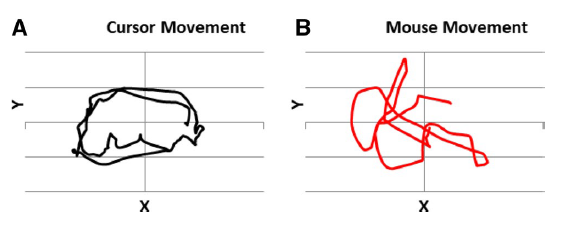RM: So you measured speed as
 ?
?
Yep. Root of the x speed squared plus the y speed squared, Pythagora’s theorem, pretty old stuff.
RM: It looks like that’s what you used in the power law plots. I presume those are measures of V plotted against R (curvature) for the participants movements.
It was curvature as C = 1/R, where R is the circle inscribed in some three very close points on the curve
RM However, if the values of R are measure of target curvature and those measures of R can be shown to be uncorrelated with the corresponding R’s for the participant’s movement then the power law relationship between R and V would provide some real evidence that the participant is slowing down through curves.
I don’t see the logic there. Participant’s and target’s C are uncorrelated, though.

Or if you prefer radius of curvature:

RM: But doesn’t that affect your measures of curvature?
Not sure what you mean, yes and no. Curvature is always the same in the same spatial points, but if the target is moving at different speeds, then it will appear at points of same curvature at different times, here is a plot, orange and red are from a PL trajectory, and blue and green from a constant speed trajectory.
AM: From my analysis of human hand trajectories - the slowing down in high curvature is real, not a statistical artifact.
RM: You are not the only one who has concluded that. I believe you are all wrong.
I know you do. Why is speed over time not convincing? That is the simplest evidence I can think of. It certainly looks like the speed is going from low to high, and it looks relatively slow exactly in the parts of high curvature, and relatively fast in parts of low curvature. The formula for speed is pretty basic too, no room for statistical tricks.

RM: Nope. I think these two equations will do:


RM: This shows that there is a mathematical correlation between curvature (R or A) and speed (V or A), the size of the correlation dependent on the correlation between curvature and affine velocity (D). So the degree to which any movement trajectory fits a power law depends on the nature of the trajectory itself, not on the way it the trajectory was generated.
I don’t see what that means. The degree to which any trajectory fits a power law depends on the trajectory. It can be generated by a person or generated by a computer program with any degree of correlation.
The power law itself does not tell you how it was generated - did someone claim otherwise?
RM: I guess you are saying that the model doesn’t behave like humans in the same situation. That’s a surprise to me since my simple tracking model does; it produces a power law when the person does and no power law when the person doesn’t (which is actually most of the time). But I’ll check it out myself with the Little Man when I get a chance.
That is not what I’m saying. For random movements of the target - the model will behave just like a person, and produce power law in the same situations. If the helicopter is slowing down in curved parts, then probably the person will slow down too, if he is tracking well. If the helicopter is not slowing down, the person might not either. The model will reproduce that behavior beautifully, great stuff. Not relevant for the power law, or rather for movement along ‘predictable’ paths. In helicopters, the ‘appearance’ of the power law depends largely on helicopter movements and how well the person can track them. In fast elliptical movements, for example, target speed profile does not really matter, as long as the cycle frequency (and average speed) are high, the person will slow down in curved parts, and go fast in other parts.
What I was saying is that for slow movements in an elliptical trajectory - if the speed of the target is constant, the model will also have a constant speed, because it is tracking well. If the target speed is not constant, and is varying with curvature, then the model will vary its speed accordingly.
When the target speed is on average high, as I showed on those plots, the model will not track accurately, neither position nor velocity, and the power law might appear, but in this case it doesn’t matter, because the accuracy is so low.







